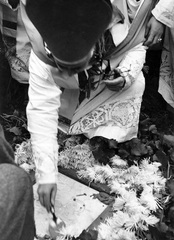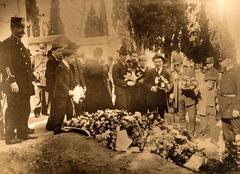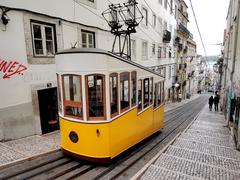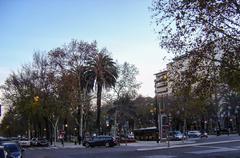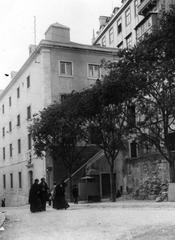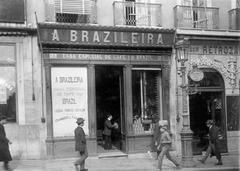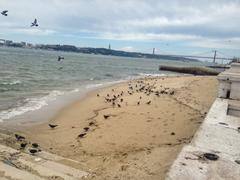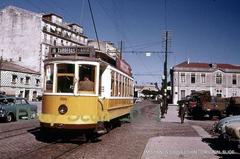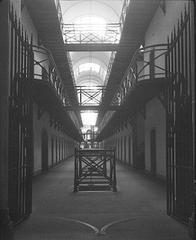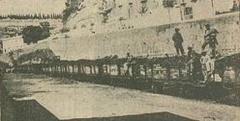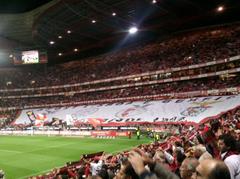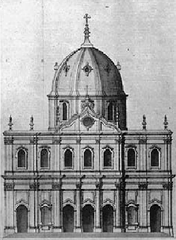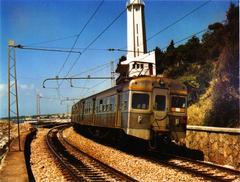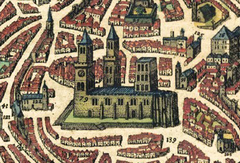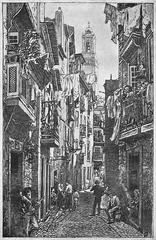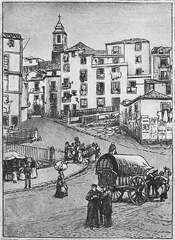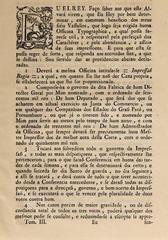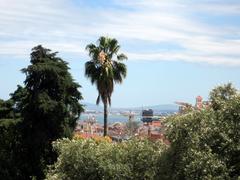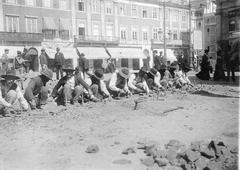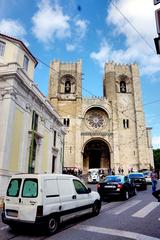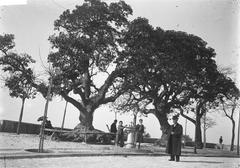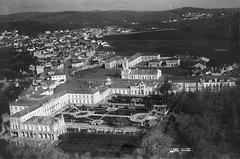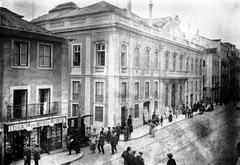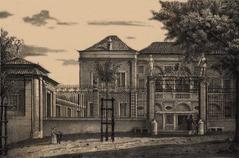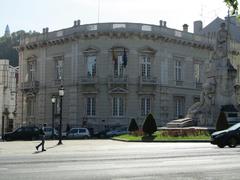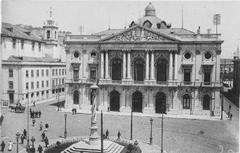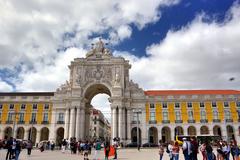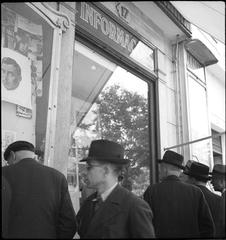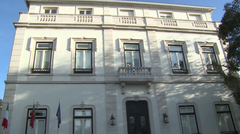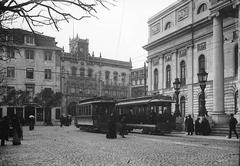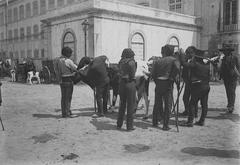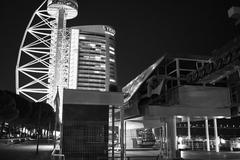
Visiting Hours and Tickets for Cristo Rei in Lisbon
Date: 17/07/2024
Introduction to Cristo Rei
Cristo Rei in Lisbon, Portugal, is a monumental statue that stands as an enduring symbol of faith, history, and cultural identity. Inspired by the renowned Christ the Redeemer statue in Rio de Janeiro, Brazil, the idea for Cristo Rei was conceived by Cardinal Manuel Gonçalves Cerejeira during a visit to Brazil in 1934. The monument was envisioned as a gesture of gratitude for Portugal’s neutrality during World War II and a symbol of peace (Visit Lisboa). The project officially began in 1940, and through nationwide fundraising efforts, construction commenced in 1949. Designed by Portuguese architect Francisco Franco de Sousa, the statue stands at an impressive height of 110 meters, including a 28-meter statue of Christ with open arms, symbolizing blessing and protection over Lisbon (Atlas Obscura) (Lisbon Guide).
The Cristo Rei statue holds deep cultural and religious significance for the Portuguese people, symbolizing peace, faith, and gratitude. It has become a pilgrimage site attracting thousands of visitors annually. The monument’s observation deck offers panoramic views of Lisbon and the Tagus River, making it a prime spot for photography and a must-visit destination for history buffs, photography enthusiasts, and those seeking spiritual solace (Portugal Visitor).
This comprehensive guide will provide you with all the essential information you need to plan your visit to Cristo Rei, including its historical context, architectural significance, visitor tips, and much more. Whether you’re planning to explore the rich history and cultural significance or simply enjoy the breathtaking views, Cristo Rei promises a memorable and enriching experience.
Table of Contents
- [History of Cristo Rei](#history-of-cristo-reihistory-of-cristo-rei)
- [Origins and Inspiration](#origins-and-inspirationorigins-and-inspiration)
- [Planning and Fundraising](#planning-and-fundraisingplanning-and-fundraising)
- [Construction and Design](#construction-and-designconstruction-and-design)
- [Inauguration](#inaugurationinauguration)
- [Symbolism and Significance](#symbolism-and-significancesymbolism-and-significance)
- [Visitor Information](#visitor-informationvisitor-information)
- [Tickets and Visiting Hours](#tickets-and-visiting-hourstickets-and-visiting-hours)
- [Getting There](#getting-theregetting-there)
- [Nearby Attractions](#nearby-attractionsnearby-attractions)
- [Special Events and Guided Tours](#special-events-and-guided-toursspecial-events-and-guided-tours)
- [Photographic Spots](#photographic-spotsphotographic-spots)
- [Preservation and Maintenance](#preservation-and-maintenancepreservation-and-maintenance)
- [Cultural Impact](#cultural-impactcultural-impact)
- [Visitor Experience](#visitor-experiencevisitor-experience)
- [FAQ](#faqfaq)
- [Future Prospects](#future-prospectsfuture-prospects)
History of Cristo Rei
Origins and Inspiration
The Cristo Rei (Christ the King) statue in Lisbon, Portugal, was inspired by the famous Christ the Redeemer statue in Rio de Janeiro, Brazil. The idea for the monument was conceived in 1934 by the Cardinal Patriarch of Lisbon, Manuel Gonçalves Cerejeira, during a visit to Brazil. Impressed by the grandeur and spiritual significance of the Brazilian statue, he envisioned a similar monument in Portugal as a symbol of peace and gratitude for the country’s neutrality during World War II (Visit Lisboa).
Planning and Fundraising
The project officially began in 1940, with the Portuguese Bishops’ Conference approving the construction. Fundraising efforts were launched nationwide, primarily through donations from the Catholic community. The campaign was highly successful, reflecting the strong religious sentiment in Portugal at the time. By 1949, sufficient funds had been raised to commence construction (Lisbon Guide).
Construction and Design
Construction of the Cristo Rei statue began in 1949 and was completed in 1959. The monument was designed by Portuguese architect Francisco Franco de Sousa, with the statue itself sculpted by Francisco Franco de Sousa. The structure stands at an impressive height of 110 meters (360 feet), including the 28-meter (92 feet) statue of Christ with open arms, symbolizing a gesture of blessing and protection over the city of Lisbon (Atlas Obscura).
Inauguration
The Cristo Rei monument was officially inaugurated on May 17, 1959, in a grand ceremony attended by numerous dignitaries, including the President of Portugal, Américo Tomás, and the Cardinal Patriarch of Lisbon, Manuel Gonçalves Cerejeira. The inauguration marked a significant moment in Portuguese history, symbolizing peace, faith, and gratitude (Portugal Visitor).
Symbolism and Significance
The Cristo Rei statue holds deep religious and cultural significance for the people of Portugal. It serves as a symbol of peace and a reminder of the country’s neutrality during World War II. The monument also represents the strong Catholic faith that has been a cornerstone of Portuguese culture for centuries. The open arms of Christ symbolize a gesture of blessing and protection, offering a sense of hope and spiritual solace to visitors and locals alike (Sacred Destinations).
Visitor Information
Tickets and Visiting Hours
Cristo Rei is open to visitors daily, with visiting hours typically from 9:00 AM to 6:00 PM. Ticket prices are reasonably priced, with discounts available for children, seniors, and groups. It is advisable to check the official website for the most up-to-date information on ticket prices and visiting hours (Sanctuary of Christ the King).
Getting There
The monument is accessible by car, public transport, or even by ferry across the Tagus River. Visitors can take a train from Lisbon to Cacilhas and then catch a bus or taxi to Cristo Rei. The site offers ample parking for those driving.
Nearby Attractions
While visiting Cristo Rei, consider exploring nearby attractions such as the Sanctuary of Christ the King, the picturesque town of Almada, and the stunning views from the Ponte 25 de Abril bridge. These sites provide additional cultural and historical insights into the region.
Special Events and Guided Tours
Cristo Rei hosts various special events and religious ceremonies throughout the year, including the annual Feast of Christ the King. Guided tours are available, offering in-depth insights into the monument’s history, symbolism, and cultural importance. These tours can be booked in advance through the official website.
Photographic Spots
The observation deck at Cristo Rei offers breathtaking panoramic views of Lisbon and the Tagus River, making it a prime spot for photography. Visitors are encouraged to capture the stunning scenery and the majestic statue from different angles.
Preservation and Maintenance
Maintaining the Cristo Rei statue is a continuous effort, involving regular inspections and conservation work to preserve its structural integrity and aesthetic appeal. The monument is managed by the Sanctuary of Christ the King, which oversees its upkeep and ensures that it remains a safe and welcoming site for visitors. Efforts are also made to enhance the visitor experience, with the addition of facilities such as a chapel, a museum, and a gift shop (Sanctuary of Christ the King).
Cultural Impact
The Cristo Rei statue has had a profound impact on Portuguese culture, becoming an iconic symbol of Lisbon and a source of national pride. It has been featured in various forms of media, including films, literature, and art, further cementing its status as a cultural landmark. The monument also plays a role in various religious and cultural events, such as the annual Feast of Christ the King, which attracts thousands of participants (Culture Trip).
Visitor Experience
Visitors to the Cristo Rei statue can enjoy a range of experiences, from exploring the monument’s history and significance to taking in the breathtaking views from the observation deck. Guided tours are available, providing in-depth insights into the monument’s history and cultural importance (Visit Portugal).
FAQ
What are the visiting hours for Cristo Rei?
Cristo Rei is open daily from 9:00 AM to 6:00 PM. It is recommended to check the official website for any changes in visiting hours.
How much do tickets to Cristo Rei cost?
Ticket prices vary, with discounts available for children, seniors, and groups. For the latest information on ticket prices, visit the official Cristo Rei website.
What is the best way to get to Cristo Rei?
Cristo Rei can be accessed by car, public transport, or ferry across the Tagus River. The most common route is to take a train to Cacilhas and then a bus or taxi to the site.
Future Prospects
Looking ahead, the Cristo Rei statue is expected to continue playing a vital role in Portugal’s cultural and religious landscape. Plans for further development and enhancement of the site are in place, aimed at improving the visitor experience and ensuring the monument’s preservation for future generations. The Cristo Rei statue remains a testament to Portugal’s rich history, faith, and enduring spirit (Portugal.com).
By understanding the history and significance of the Cristo Rei statue, visitors can gain a deeper appreciation for this iconic landmark and its place in Portuguese culture.
Conclusion
Visiting Cristo Rei in Lisbon is an unforgettable experience that offers a unique blend of historical, cultural, and spiritual insights. The monument stands as a testament to Portugal’s rich history and enduring faith, symbolizing peace and gratitude for the country’s neutrality during World War II. Its towering presence and the panoramic views it offers make it a must-visit destination for anyone traveling to Lisbon (Sanctuary of Christ the King).
The comprehensive guide provided here covers everything from the monument’s historical context and architectural significance to practical tips on visiting hours, ticket prices, and travel tips. Whether you are a history enthusiast, a photography lover, or simply seeking a peaceful retreat, Cristo Rei offers something for everyone. The site’s accessibility, nearby attractions, and guided tours further enhance the visitor experience, ensuring that everyone can enjoy the monument’s beauty and significance (Culture Trip).
Looking ahead, Cristo Rei is expected to continue playing a vital role in Portugal’s cultural and religious landscape. Efforts to preserve the monument and enhance the visitor experience are ongoing, ensuring that Cristo Rei remains a cherished landmark for future generations. As you plan your visit, remember to check for the latest updates and information on the official Cristo Rei website (Portugal.com).
For more travel tips and updates, consider following us on social media or downloading our mobile app Audiala. By following these tips, you can ensure a memorable and enjoyable visit to Cristo Rei, one of Lisbon’s most iconic landmarks.
